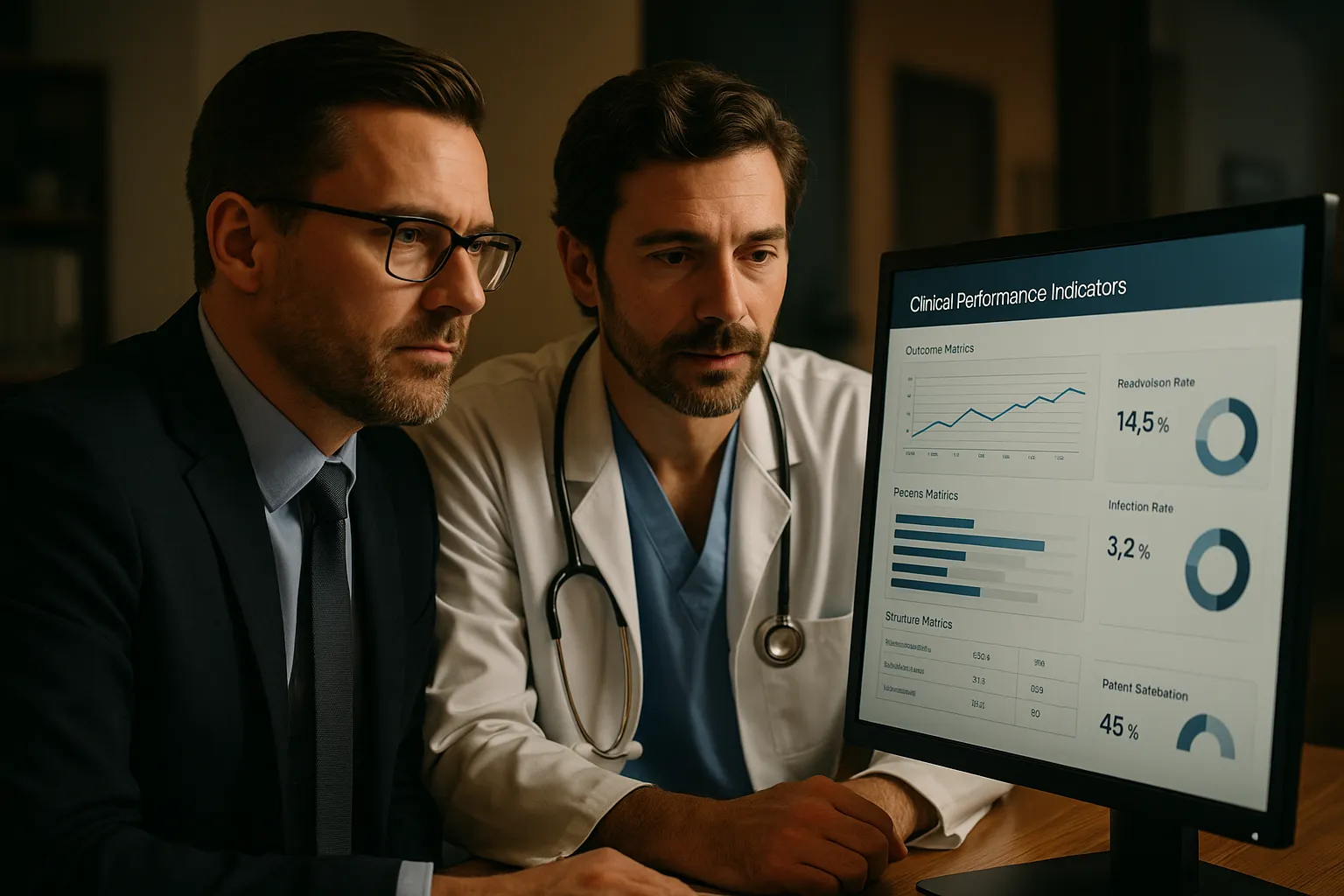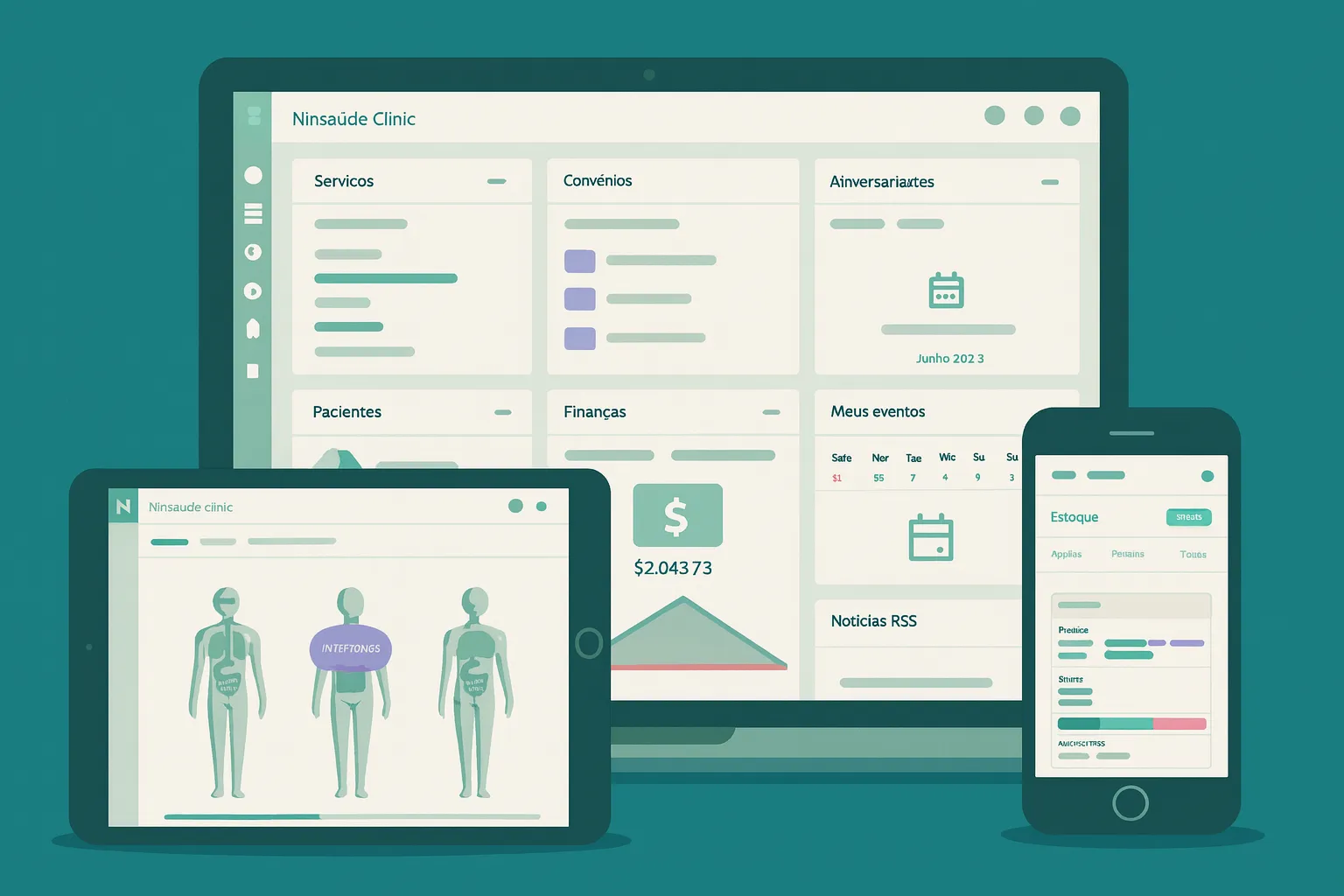
The quality of healthcare is directly tied to the ability of medical institutions to monitor, measure, and continuously improve their care processes. In a scenario where evidence-based medicine is increasingly essential, clinical performance indicators emerge as key strategic tools to optimize outcomes, reduce costs, and ensure patient safety.
Effectively implementing these indicators goes beyond simply collecting numbers. It requires an integrated approach that involves healthcare professionals, administrative managers, and IT specialists working together to create a robust and actionable data ecosystem. In this article, we’ll explore practical strategies and proven methodologies to implement clinical performance indicators that truly add value to your institution, covering everything from proper metric selection to the necessary technology integration.
Before we continue, we need to ask: Are you already familiar with Ninsaúde Clinic? Ninsaúde Clinic is a medical software with an agile and complete schedule, electronic medical records with legal validity, teleconsultation, financial control and much more. Schedule a demonstration or try Ninsaúde Clinic right now!

Defining Clinical Performance Indicators
Clinical performance indicators are quantitative metrics that evaluate specific aspects of the quality, efficiency, and effectiveness of healthcare delivery. They serve as benchmarks of care quality, allowing institutions to identify trends, compare performances, and establish both internal and external benchmarks.
These indicators can address different dimensions of care, ranging from direct clinical outcomes to operational processes and patient experience. Examples include hospital readmission rates, infection indexes, average wait times for appointments, and patient satisfaction levels.

Essential Types of Indicators
Outcome Indicators
Focus on the final results of care provided and are considered the most important for assessing clinical effectiveness. Examples include mortality rates, postoperative complication indexes, cure rates, and chronic disease control levels.
Process Indicators
Evaluate how care is delivered, focusing on the adequacy of clinical and administrative processes. Examples include average consultation time, adherence to clinical guidelines, preventive exam utilization rates, and percentage of guideline-based prescriptions.
Structure Indicators
Relate to the resources available to deliver care, including human, technological, and physical resources. Examples include the number of beds per inhabitant, nurse-to-patient ratios, and availability of specialized equipment.
The Indicator Selection Process
Selecting appropriate indicators is a strategic process that must consider multiple factors. First, it’s essential to identify institutional objectives and priority improvement areas. For instance, a cardiology clinic should prioritize indicators related to cardiovascular diseases, while a general practice clinic should focus on broader primary care metrics.
The “SMART” concept (Specific, Measurable, Achievable, Relevant, Time-bound) should guide selection. Specific and measurable indicators ensure clarity in data collection and interpretation. Feasibility of collection and relevance to clinical practice are equally important, as well as setting appropriate timelines for assessment and review.
Platforms like Ninsaúde Clinic make this process significantly easier by offering integrated tools for defining and customizing indicators according to the specific needs of each institution. The platform allows managers to configure personalized dashboards that automatically track the most relevant metrics for their clinical context.

Required Technological Infrastructure
Effective implementation demands a strong technological infrastructure. The essential component is an Electronic Health Record (EHR) system that captures data in a structured and standardized way. Inconsistent data can severely compromise indicator quality.
Interoperability between systems is critical. Many clinics use different software for scheduling, billing, labs, and patient records. The ability to integrate this information is fundamental for comprehensive indicators. Solutions like Ninsaúde Clinic address this challenge by offering an integrated platform that centralizes all functionalities, eliminating information silos.
Processing and storage capacity must also be considered. Effective indicators require historical analysis and temporal comparisons, demanding systems capable of efficiently storing and processing large data volumes. In addition, backup and recovery functionalities are essential to ensure monitoring continuity.
Data Collection and Standardization
The quality of indicators depends on the quality of data collected. Establishing clear collection protocols is critical, defining exactly what data to collect, when, who is responsible, and how it should be recorded in the system.
Standardization of medical terminology is crucial. Using recognized classifications such as ICD-10 or SNOMED CT ensures consistency and facilitates comparisons. Automatic validation of data at entry identifies inconsistencies and out-of-range values, prompting immediate corrections.
Developing Dashboards and Reports
Effective dashboards transform raw data into actionable insights through clear and intuitive visualizations. Design should prioritize usability, presenting critical information prominently and allowing for multiple levels of detail.
Customization is essential to meet different user profiles. Physicians may prefer dashboards focused on specific clinical indicators, while managers may require broader views including financial and operational aspects. Drill-down functionality allows navigation from general overviews to detailed analyses.
Practical Implementation and Change Management
Implementation requires a structured change management approach. It’s essential to start with a pilot project in a specific area, testing processes before scaling up. Team engagement is crucial—professionals must understand not only how to collect data but also why these indicators matter.
Establishing internal champions—professionals who become experts in the new processes—is an effective strategy to accelerate adoption. These champions identify resistance, suggest improvements, and serve as liaisons between leadership and frontline staff.

Analysis and Interpretation of Results
Proper analysis is key to extracting value from indicators. Establishing appropriate benchmarks contextualizes results, including internal targets based on historical performance or industry standards.
Trend analysis provides insights into performance evolution. Seasonal variations, organizational changes, or intervention effects can be identified through longitudinal analysis. Comparative analysis across different units may reveal best practices worth replicating.
Improvement Actions and Feedback Cycles
Indicators only add value when they lead to concrete actions. Establishing clear protocols for responding to out-of-range indicators is essential. The PDCA (Plan-Do-Check-Act) cycle offers a useful framework for implementing data-driven improvements.
Solutions like Ninsaúde Clinic streamline this process by enabling real-time monitoring of interventions and their impact on indicators, accelerating feedback cycles. Regular communication of results to the entire team keeps focus on continuous improvement.
Privacy and Security Considerations
Implementation must strictly adhere to regulations such as HIPAA. Patient data should be anonymized for aggregated analyses, minimizing exposure risks. Role-based access controls ensure users only see data relevant to their responsibilities.
Data encryption in transit and at rest is essential, especially when indicators are shared across systems. Secure backups and recovery plans ensure continuity of monitoring systems.

Sustainability and Continuous Evolution
Maintaining a clinical performance indicator system requires ongoing resources and long-term organizational commitment. Regular review and update processes ensure indicators remain relevant as institutions evolve and new scientific evidence emerges.
Continuous staff training is essential to maintain data quality and effective use of indicators. This includes training on new system features, updates to clinical guidelines, and development of analytical skills.
Investing in emerging technologies such as artificial intelligence and machine learning can greatly enhance the value of indicators, enabling predictive analytics and automatic identification of complex patterns in data.
Did you like this information? Then get ready for a continuous learning journey by following our blog. Are you a healthcare professional and don’t yet know the benefits of Ninsaúde Clinic? Stay ahead, optimize your processes, and raise the standard of patient care!

